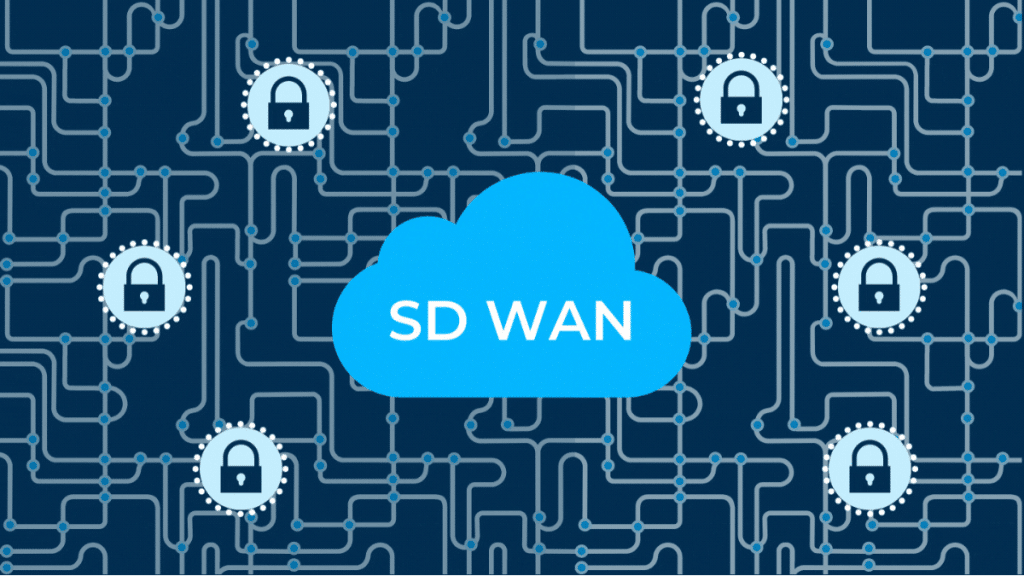Introduction
Corporate traffic patterns have changed radically. Instead of routing everything to a central data center, employees now open Microsoft 365 in a café, sync Salesforce from the airport, and join Zoom meetings from a spare bedroom. Traditional WAN architectures-built on private MPLS circuits and router-by-router rules-were never designed for this everywhere-to-everywhere model. Enter software-defined wide-area networking (SD-WAN): a policy-driven overlay that lets IT teams steer traffic, harden security, and trim transport bills without touching every box on every site.
The Basics of SD-WAN
SD-WAN separates the decision-making control layer from the packet-forwarding data layer. A central orchestrator defines global policy-“Video gets top priority,” “Encrypt payments,” “Send backups after hours”-while branch-edge devices enforce it in real time across whatever links they have available: DIA fiber, commodity broadband, LTE/5G, or legacy MPLS. By abstracting physical circuits into a virtual fabric, SD-WAN gives companies fast lane control that legacy WANs simply lack.
Curious about how does SD-WAN work in network performance? It’s quite elegant: the system constantly measures critical factors like latency, jitter, and packet loss across every available network path. This real-time intelligence allows SD-WAN to dynamically redirect crucial traffic, such as Office 365, SAP applications, and video calls, to the healthiest, most performant link at any given moment. The net result is noticeably snappier and more reliable cloud access, often without the need for expensive over-provisioning of bandwidth.
Core Components of SD-WAN Architecture
- Edge Devices
Small appliances-or virtual machines in cloud VPCs-establish encrypted tunnels (often IPsec or SSL) across all available circuits, then classify and forward traffic according to policy. - Controller / Orchestrator
A cloud-hosted or on-prem brain that maintains global topology, pushes configuration, and collects telemetry. - Overlay Network
Secure virtual paths built atop physical underlays. Overlays mask the quirks of individual circuits, allowing active-active bandwidth use and hitless failover. - Management Portal
A single HTML5 dashboard where administrators tweak QoS, spin up new branches with zero-touch provisioning, or drill into application heat maps. Industry research by Gartner shows that centralized SD-WAN management can cut change-window times by up to 50 percent.
Intelligent Traffic Routing
Unlike static WANs that push everything down a default MPLS pipe, SD-WAN continuously probes each circuit. If packet loss on cable broadband creeps above, say, 2 percent, the edge can shift voice traffic to a clean LTE link while leaving bulk backups on the degraded line. Mission-critical packets follow the best available path instead of the only path.
- Real-time link scoring. Many vendors sample every few hundred milliseconds.
- Application fingerprints. Engines recognize Zoom, Teams, or SAP based on packet heuristics-even when those apps hop ports.
- Policy hierarchy. Business rules override generic QoS, letting finance traffic trump an overnight OS update.
For deep-dive performance analytics, tools such as ThousandEyes integrate with leading SD-WAN platforms, overlaying Internet health maps atop the controller’s telemetry.
Built-In Security Functions
Because SD-WAN often breaks traffic out to the Internet locally, robust security is non-negotiable.
- Full-tunnel Encryption – AES-256 IPsec secures data over untrusted broadband.
- Segmentation – Micro-segments isolate a point-of-sale terminal from guest Wi-Fi.
- NGFW & IDS/IPS – Many solutions embed next-gen firewall engines at the edge, blocking threats before they traverse the overlay.
- Policy-Based Access – Rules can whitelist Salesforce for sales laptops but deny it on an IoT kiosk.
The Center for Internet Security notes that edge-embedded security reduces the need to backhaul traffic to a central filter, preserving bandwidth while tightening compliance.
Application Awareness and QoS
Legacy QoS treated all port 80 traffic alike, whether it was a video meeting or an ad download. SD-WAN classifies flows by application signatures, not ports:
- Identify. DPI engines spot more than 3,000 apps, including encrypted SaaS.
- Prioritize. Critical apps receive gold, silver, or bronze lanes.
- Shape. Non-essential traffic can be rate-limited during business hours.
Such fine-grained QoS explains why research from IDC projects a double-digit CAGR for SD-WAN, as enterprises move voice and video off expensive MPLS.
How SD-WAN Supports Cloud and SaaS Traffic
Direct Internet Access (DIA) from each branch slashes the latency penalty of backhauling to HQ. Edge devices can:
- Form IPsec tunnels straight into AWS or Azure gateways.
- Leverage API integrations with Microsoft’s Virtual WAN hubs for optimized Office 365 routing.
- Automate policy-for instance, pinning latency-sensitive IaaS to the lowest RTT link.
With SaaS now comprising over 50 percent of enterprise traffic, these optimizations often provide the first tangible win IT can showcase.
Centralized Management and Automation
Zero-touch provisioning means shipping a factory-sealed appliance to a new store, plugging it in, and watching it self-register with the orchestrator. From there, admins can:
- Clone policies to 200 branches in minutes.
- Push firmware during low-traffic windows automatically.
- Analyze dashboards that correlate jitter spikes with user-reported slowdowns.
Automation scripts, usually exposed through REST APIs, let DevOps teams fold network changes into CI/CD pipelines-“infrastructure as code” extends to the WAN.
Conclusion
SD-WAN shifts wide-area networking from box-by-box tinkering to software defined intent. By measuring path health, prioritizing applications, encrypting traffic, and automating rollout, the technology provides a blueprint for networks that are faster, cheaper, and safer than their legacy counterparts. As multi-cloud adoption and hybrid work continue to surge, understanding how the pieces-edge, controller, overlay-fit together equips IT teams to build resilient, future-ready connectivity.
Frequently Asked Questions
Q1: Can I keep my MPLS circuits after moving to SD-WAN?
Absolutely. Most deployments start hybrid-MPLS for deterministic performance, broadband/5G for cost-effective bandwidth. Policies decide which traffic rides which path.
Q2: Does SD-WAN replace my existing firewall?
Many vendors embed NGFW services in the edge device. Whether that fully replaces standalone firewalls depends on compliance mandates, traffic volume, and advance inspection needs.
Q3: How long does it take to deploy SD-WAN to 50 branches?
With zero-touch provisioning, initial pilots can light up in days. Full rollouts often complete in 4-12 weeks, paced primarily by ISP circuit delivery rather than SD-WAN configuration.
